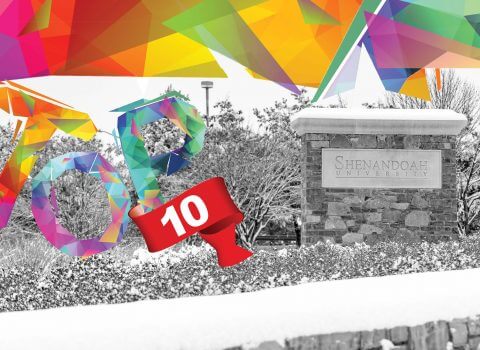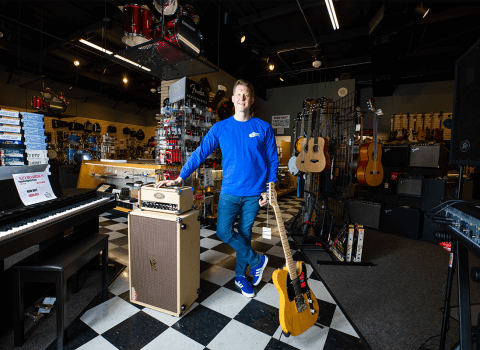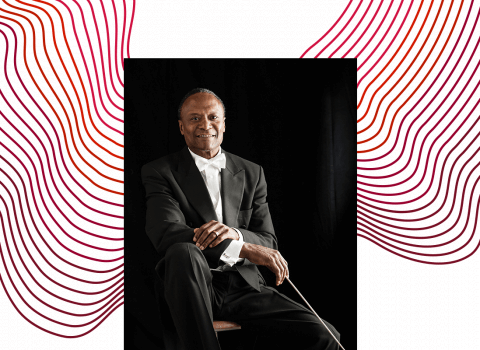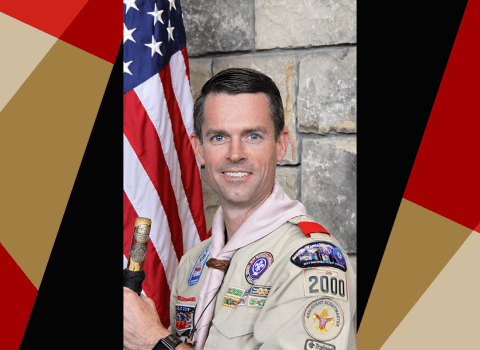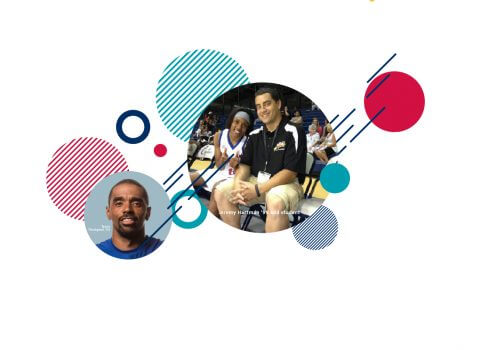A lot can happen in 25 years. If you were an adult in 1991, you’ve likely traded your mixtape for a Pandora playlist, recycled your World Book Encyclopedia for an internet search on your smartphone and now spend nights watching “The Tonight Show” with Jimmy Fallon, rather than Johnny Carson, on your 60-inch flat-screen TV.
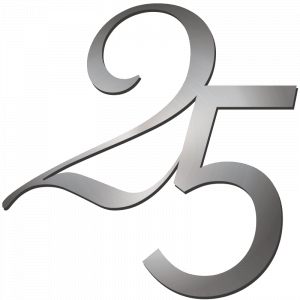 Shenandoah, too, has grown dramatically, adding new programs and facilities, expanding its reach beyond main campus — and becoming stronger financially and reputationally — while serving in a more engaged role in the local community and providing a global reach that is wider and deeper than ever before. Yet in the days and months preceding the moment when the clock struck midnight on New Year’s Eve, Dec. 31, 1990, the former Shenandoah College and Conservatory of Music was working toward becoming something new — it was becoming a university.
Shenandoah, too, has grown dramatically, adding new programs and facilities, expanding its reach beyond main campus — and becoming stronger financially and reputationally — while serving in a more engaged role in the local community and providing a global reach that is wider and deeper than ever before. Yet in the days and months preceding the moment when the clock struck midnight on New Year’s Eve, Dec. 31, 1990, the former Shenandoah College and Conservatory of Music was working toward becoming something new — it was becoming a university.
Share your SU Memories of the Past 25 Years
Becoming A University
The decision to become a university began as a bold, strategic idea. By fall 1990, under the leadership of President Emeritus James A. Davis, Ph.D., Shenandoah College and Conservatory already met much of the criteria required for university status with a mix of undergraduate and graduate programs, a number of programs in various academic disciplines, a percentage of faculty with terminal degrees and multiple campus locations. So, the switch to university status offered an attractive opportunity to bolster reputation while more accurately reflecting the growing diversity of its academic offerings.
“Perhaps the greatest boost to Shenandoah in 1991 was the added recognition as a quality institution gained from university status, membership in the Virginia Foundation of Independent Colleges and the new supporters [gained] through the campaign to fund the new Alson H. Smith, Jr. Library,” wrote Dr. Davis in the 1991 president’s report. “These achievements resulted in a higher number of applicants for admission, attraction of better qualified faculty and staff and enhanced operating revenues to advance new programs,” he wrote.
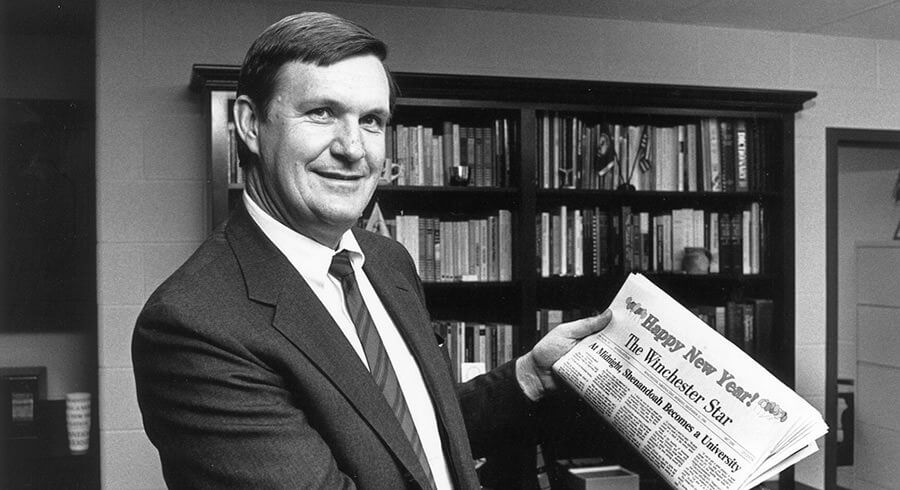
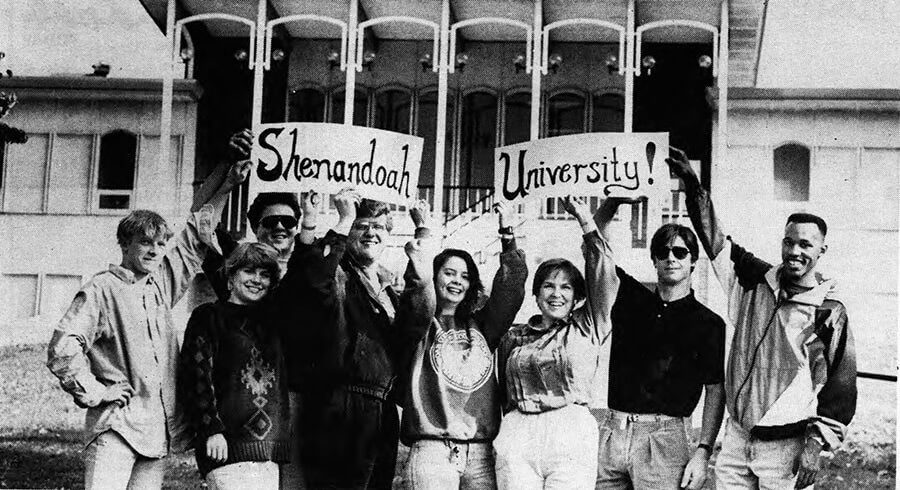
According to Davis, university status also raised awareness for the arts in the region, helped businesses to increase the caliber of their professional staffs through graduate studies and opened the doors to creating graduate programs for educators. It helped support the expansion of skilled health professionals at the Winchester Medical Center and other health providers throughout the region. Finally, university status helped boost Shenandoah’s image abroad among international students who, at the time, came from more than 70 countries, and it opened doors for new revenue opportunities with foundations and government grants.
“I felt strongly we needed to take the steps to serve our region,” said Davis. “I knew health professions in physical therapy, occupational therapy, physician assistant studies, pharmacy, nursing and respiratory care would be in demand for decades to come. I was very pleased with all of those programs and our subsequent strides in [offering] graduate-level education. Of course, we were also able to keep the conservatory very competitive, and it grew in strength. Today, Shenandoah is wonderfully positioned as a university that serves the higher education needs of the region, where it has gained distinction as a vital force for good.”
John Kennedy said, ‘Leadership and learning are indispensable to one another.’ Shenandoah University continues to be committed to student success by embracing excellence and creativity as it grows future leaders.” —Maryam Tabatabai ’00
Shenandoah Then and Now By the Numbers
Shenandoah Then and Now
President Tracy Fitzsimmons, Ph.D., arrived on main campus in 2001 as dean of the College of Arts & Sciences, later becoming the university’s first female vice president for academic affairs in 2002, senior vice president in 2006 and the first female president in 2008. Her tenure at Shenandoah, which spans more than half the years it has been a university, provides a unique perspective on the university’s past, present and future trajectory.
“Twenty-five years ago, we had fewer than 1,500 students,” said Dr. Fitzsimmons. “We didn’t have a pharmacy school, PT, OT, AT or PA programs. We didn’t have doctoral programs in education or in the conservatory. We didn’t yet have the main library building. We didn’t have the health professions building. We didn’t have a student center, Halpin-Harrison Hall or the Perry-Warner End Zone Building. We didn’t have the Health & Life Sciences Building. We didn’t have Davis Hall. It was a totally different place.
“Twenty-five years later — thanks to the extraordinary work of President Jim Davis, the board of trustees, the faculty and staff, the alumni who supported us and this local community — we are nearly 4,000 students strong,” she said. “We have national rankings and reputation in a number of programs. We have a [robust] health professions program, a world-class conservatory, a strong and growing College of Arts & Sciences and a school of business. Of course, we have offered nursing for a long time, and that continues to flourish, but we’ve added master’s and doctoral-level programs there as well. We have a larger enrollment and a stronger operating budget. Our fundraising capabilities are stronger, too, and our donors are more generous than ever. For that, I’m grateful.”
Shenandoah Athletics also grew over the years, attracting more students to campus and expanding the student life experience. In 1991, the Department of Intercollegiate Athletics was less than half its current size (10 sports versus 21 today). It consisted of approximately 150 student-athletes and was led by a part-time coaching staff with no full-time head coaches. Since that time, the university has added 11 intercollegiate programs, six of them for women, the department staff has grown to 30 full-time coaches, athletic trainers and administrators and boasts nearly 500 student-athletes.
The university also expanded acreage to main campus, adding the property where Shentel Stadium now stands, rented and purchased facilities in downtown Winchester and on the campus of the Winchester Medical Center, acquired stewardship of the historic Cool Spring battlefield property on the banks of the Shenandoah River and added programs and facilities in Northern Virginia — all new initiatives.
I am glad that Shenandoah College became Shenandoah University, because it has opened the door for students to take their education to the next level by offering post-graduate programs that resulted in me obtaining my MBA. —Becky Merriner ’01
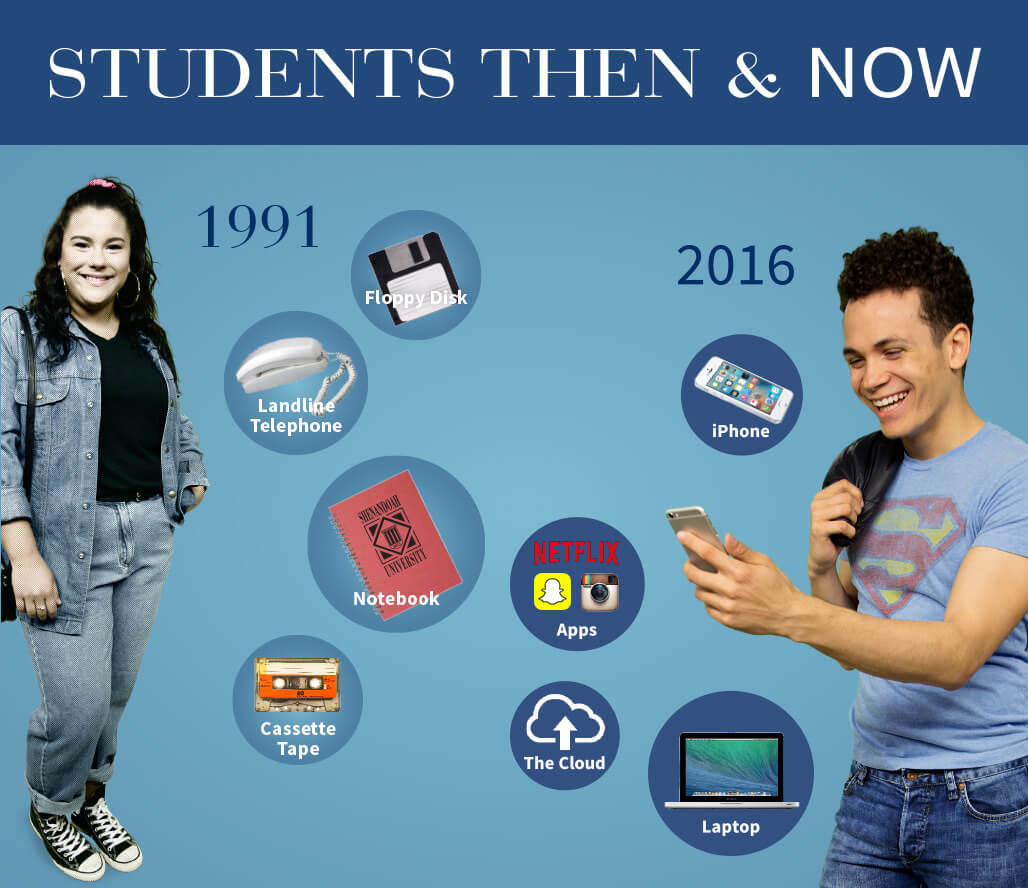
A ‘Home’ for Multiple Degrees
“When Shenandoah was a two-year institution, students would come here, or to Dayton, to do their two-year studies, then they would go on somewhere else to do their graduate studies,” said Fitzsimmons. “Now they can come to Shenandoah in year one as a freshman and can continue all the way through to a doctorate. This is a home where you begin your studies, and you can continue all the way through to your final graduation with the readiness to launch [a career].
“So, you can come here for pre-health and stay here for your graduate degree,” said Fitzsimmons. “You don’t have to leave to go somewhere else, and students can often complete their degrees in a condensed fashion. That’s good for students because it gets them out into the job market earlier, and it means they spend one less year on tuition. You can earn a master’s and doctorate in many areas of the conservatory. You can stay and get your Ed.D., if you’re an educator. You can stay in business and get your MBA. You can go all the way to your M.S.N. or D.N.P., if you’re in nursing. Some people will stay all the way through, and some will take time off and come back home [to Shenandoah] later to get their degree.”
That does not mean Shenandoah positions itself to be all things to all people.
“That was never our goal, but what we do, we do very well, and we do it completely,” said Fitzsimmons.
What’s in a Name?
The university has worn many names since its inception in 1875, opening its doors as Shenandoah High School in 1875 and renaming the institution Shenandoah Seminary in 1876. As it grew, it became Shenandoah Institute in 1885, Shenandoah Collegiate Institute and School of Music in 1902, Shenandoah College in 1925, Shenandoah College and Shenandoah Conservatory of Music in 1937, Shenandoah College and Conservatory in 1974 and, finally, Shenandoah University in 1991.
25 Years of Trailblazing in Higher Education
Shenandoah, through the years, has served as an educational trailblazer, adding programs and/or services years or decades ahead of the curve, like adding graduate programs in the health professions and pioneering the first pharmacogenomics program in the nation. The university was also one of the first to offer an online terminal degree for working, non-traditional pharmacists, a master’s in physician assistant studies, a master’s in athletic training and a hybrid master’s in occupational therapy. It partnered with other colleges and universities to serve rural health needs while extending ways for students to earn their master’s in nurse-midwifery. Today, Shenandoah continues to remain on the leading edge in health education as it expands into new areas like genomics and genetic counseling.
With an eye for compassionate service and understanding beyond its own borders, the university also pioneered a strong focus on global citizenship.
“Everybody is talking about global citizenship now,” said Fitzsimmons. “I’m so glad about that, but we started talking about global citizenship 12-15 years ago. We were at the forefront of that discussion, and with it we established [our unique] Global Citizenship Project, something I still don’t think you can find anywhere else.”
Another way Shenandoah University has innovated is by fusing career preparation within a liberal arts foundation.
“Shenandoah has always been focused on career preparation for students,” said Fitzsimmons. “We haven’t jumped on some national trend. We led that trend. If you look across the country, there are lots of liberal arts institutions that are now adding career-training professional programs. We’ve been doing that for decades, [because] we think it’s important to train our students to be prepared for a career and to be prepared for lifetime of good decisions. That’s not new. That’s not some bandwagon we’re jumping on. That’s a trend we are leading.
“Shenandoah also leads in being purposeful about the outcome students can expect when they graduate,” said Fitzsimmons. “Our vision is to graduate students who are competitive and purposeful. The concept that you can be both compassionate and achieve excellence, and that these things not only can exist, but should co-exist…I think we are also at the front end of that trend,” said Fitzsimmons.
‘Leaning in’ to the Future
The university remains aligned with its roots as a caring community rich in creative energy and intellectual challenge. At the 25-year mark, it is strong, financially secure and stable. Enrollment continues to grow. Yet Shenandoah remains a place that’s on the move.
“We’re always looking for where we can better serve students, and we’re looking [at the future] from a position of strength,” said Fitzsimmons. “What do we retain? We retain the heart of this place; that heart you can trace all the way back to our years in Dayton is still here. That sense that we are a community; that we take care of our own. We remember that every student who goes here is someone’s child.”
